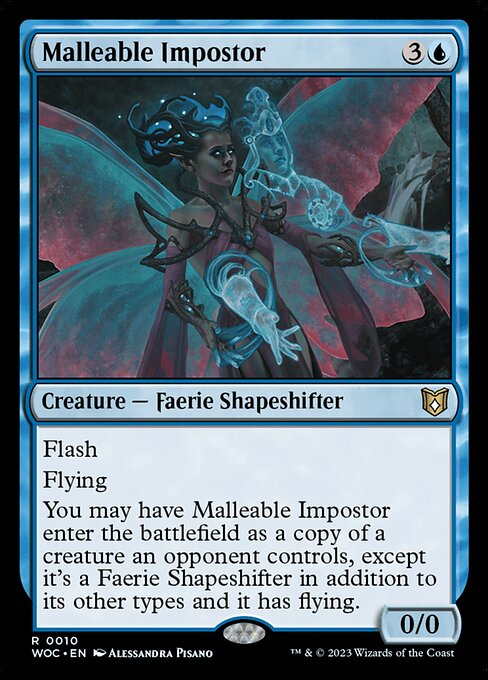
Image courtesy of Scryfall.com
Brushing Fairy Tales: The Malleable Impostor’s Journey from Canvas to Core Set
Magic art isn’t just decoration; it’s a narrative bridge between gameplay mechanics and the worldbuilding that makes MTG feel alive. The Malleable Impostor, a rare from the Wilds of Eldraine Commander set released in 2023, sits at a fascinating crossroads of traditional artistry and modern digital production. With a mana cost of {3}{U}, this blue creature embodies the season’s penchant for clever tricks and fairy-tue wonder, and its artwork—crafted by Alessandra Pisano—shows how illustrators translate a shapeshifter’s sly energy into a single frame. 🧙♂️🔥
The image captures a moment of poised deception: a winged figure that seems to shift its silhouette mid-air, hinting at the card’s core ability to enter as a copy of an opponent’s creature, all while retaining its Faerie Shapeshifter identity and the ever-present gleam of blue magic. In the Eldraine universe, where fairy-tale motifs meet high-stakes spellcraft, Malleable Impostor feels like a living word balloon—the kind of character who would appear in a forest glade and instantly spark a table-wide “what if?” discussion. The art’s cool blues, contrasted highlights, and airy composition emphasize not just the look of a copy, but the sensation of transformation itself. 🎨🧩
Design, Flavor, and the Copycat Mechanic
At the table, the card’s abilities read as a tactical whisper: Flash; Flying; You may have this creature enter as a copy of a creature an opponent controls, except it’s a Faerie Shapeshifter in addition to its other types and it has flying. That means you can skirt around blockers or surprise an opponent’s big threat by arriving as their own threat, only to flip the script the moment you reveal the copy’s true nature. The flavor text and the art reinforce this idea of identity as a mutable, fluid thing—an invitation to view combat as a stage where appearances matter just as much as stats. The combination of Flash and Flying elevates its utility in Commander games, where tempo and surprise can swing a game’s trajectory in the blink of an eye. 💎⚔️
Traditional vs Digital: A Quick Comparison
- Traditional illustration often carries a tactile resonance—the texture of brushwork, the warmth of a hand-drawn line—which can feel more intimate when you hold a physical card.
- Digital illustration enables precise color control, cleaner edges for card readability, and flexible lighting passes that enhance legibility across varying print runs and display formats.
- The Malleable Impostor art blends painterly softness with crisp focal points, a hallmark of a piece designed to read well both on a sleeve and on a screen. That duality mirrors the card’s own dual nature: a familiar creature in an unfamiliar form with a dash of ethereal charm. 🧙♂️
- From a collector’s view, digital pipelines allow artists to iterate on color grading and glow effects before committing to a final print, a practice that helps preserve the card’s magical aura in every edition. 🔥
Artist Spotlight: Alessandra Pisano and the Eldraine Aesthetic
Pisano’s work on Eldraine leans into luminous color and kinetic composition, balancing the folklore glow with modern polish. The Malleable Impostor stands as a vivid example of how her brushwork—whether in traditional studies or digital refinements—can convey movement and misdirection in a single frame. In a world where every card is a tiny, portable painting, Pisano’s approach helps the viewer feel the moment of a shape-shifter’s first breath before the illusion takes form. It’s a reminder that fantasy art in MTG is as much about mood as it is about line and color—and that mood travels well from a gallery wall to a tabletop. 🎲🎨
Set, Rarity, and the Collector Perspective
As a rare from a Commander-centric set, Malleable Impostor sits in a sweet spot for players who value both clever gameplay and distinctive art. The card’s 2023 release date places it firmly in the “modern era” of MTG collecting, where popular mechanics—like entering as a copy—combine with evocative visuals to create a memorable card experience. Its blue identity, rarity, and the Eden-like Eldraine setting all contribute to its appeal for casual collectors and EDH enthusiasts alike, who relish the idea of a deck that can mimic, mask, and maneuver in ways that feel almost cinematic. ⚔️🧙♂️
Practical Takeaways: How to Appreciate Both Worlds
When you study Malleable Impostor, you’re not just looking at a clever card; you’re examining the fusion of painterly craft and digital finesse that powers today’s MTG visuals. Consider how the art communicates the card’s utility at a glance: the sense of flight, the shimmer of illusion, and the way the figure’s identity remains both recognizable and unsettled. That tension is the heartbeat of great illustration, whether it’s brushed on paper or rendered with a stylus. For those who want to celebrate the artistry beyond the game table, a well-lit display and a high-resolution print will keep the image crisp, just as a high-res mouse pad can keep your desk in harmony with your gaming rhythms. 🧙♂️🎲
And if you’re looking to level up your setup while supporting artists who bring MTG’s worlds to life, consider something that complements your card obsession with a practical touch of flair. A neon, high-resolution mouse pad is a small, tactile reminder of the same precision and color-work you admire in the art studio—an easy bridge between gallery-worthy images and everyday play. The link below points you toward a product that pairs nicely with marathon drafting sessions and coffee-fueled deck tweaks. ⚡